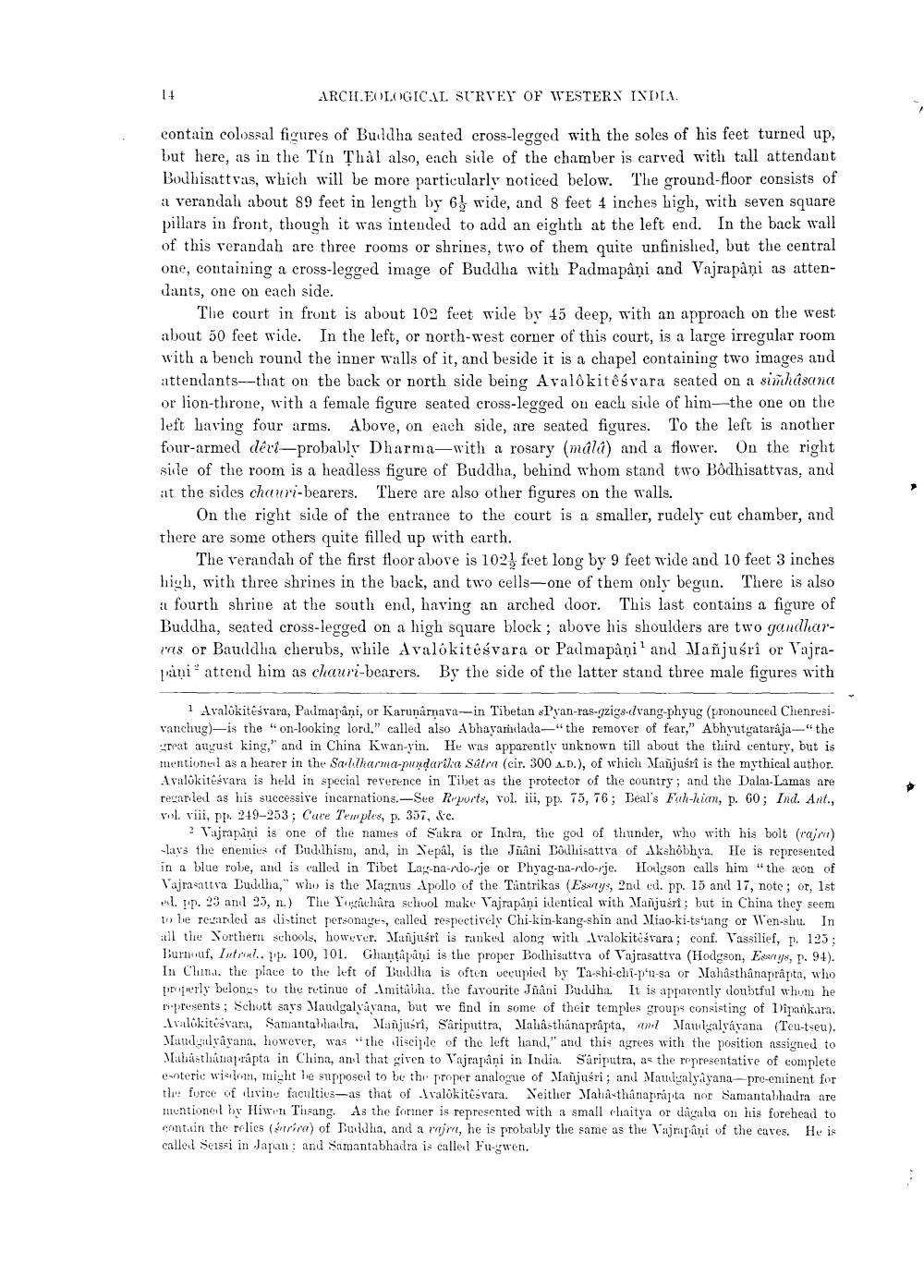________________
ARCHEOLOGICAL SURVEY OF WESTERN INDIA.
contain colossal figures of Buldha seated cross-legged with the soles of his feet turned up, but here, as in the Tín Thål also, each side of the chamber is carved with tall attendant Bodhisattvas, which will be more particularly noticed below. The ground floor consists of a verandah about 89 feet in length by 6! wide, and 8 feet 4 inches high, with seven square pillars in front, though it was intended to add an eighth at the left end. In the back wall of this verandah are three rooms or shrines, two of them quite unfinished, but the central one, containing a cross-legged image of Buddha with Padmapâņi and Vajrapàņi as attendants, one on each side.
The court in front is about 102 feet wide by 45 deep, with an approach on the west about 50 feet wide. In the left, or north-west corner of this court, is a large irregular room with a bench round the inner walls of it, and beside it is a chapel containing two images and attendants--that on the back or north side being Avalokitesvara seated on a simhasana or lion-throne, with a female figure seated cross-legged on each side of him--the one on the left having four arms. Above, on each side, are seated figures. To the left is another four-armed déri-probably Dharma-with a rosary (mála) and a flower. On the right siile of the room is a headless figure of Buddha, behind whom stand two Bodhisattvas, and at the sides chauri-bearers. There are also other figures on the walls.
On the right side of the entrance to the court is a smaller, rudely cut chamber, and there are some others quite filled up with earth.
The verandah of the first floor above is 1021 feet long by 9 feet wide and 10 feet 3 inches high, with three shrines in the back, and two cells-one of them only begun. There is also a fourth shrive at the south end, having an arched door. This last contains a figure of Buddha, seated cross-legged on a high square block; above his shoulders are two gandharms or Bauddha cherubs, while Avalokitesvara or Padmapåņi' and Mañjuśrî or Vajrafråni' attend him as chauri-bearers. By the side of the latter stand three male figures with
1 Avalokitesvara, Paumapani, or Karunârnava---in Tibetan Pyan-ras-gzigs-vang-phyug (pronounced Chenresivanchug)—is the "on-looking lord." called also Abhayamada—"the remover of fear," Abhyutyataraja-"the
reat august king," and in China Kwan-yin. He was apparently unknown till about the third century, but is mentioned as a hearer in the Salilharma-pundarika Satra (cir. 300 A.D.), of which Maijusrî is the mythical author.
1 valokitesvara is held in special reverence in Tibet as the protector of the country; and the Dalai Lamas are recarled as his successive incarnations.-See Reports, vol. iii, pp. 75, 76; Deal's Fuh-hian, p. 60; Ind. Ant., vol. viii, pp. 219-253; Care Temples, p. 357, &c.
? Vajrapani is one of the names of Sakra or Indra, the god of thunder, who with his bolt (raji) lays the enemies of Buddhism, and, in Nepal, is the Jhini Bodhisattva of Akshobhya. He is represented in a blue robe, and is called in Tibet Lay-na-rdo-rje or Phyag-na-rdo-rje. Hodgson calls him "the won of Vajra-attva Luddha," who is the Magnus Apollo of the Tantrikas (Esrtys, 2nd ed. pr. 15 and 17, note; or, 1st m.in. 23 anl 25, n.) The Y achara school make Vajrapiņi identical with Manjusri; but in China they seem to be resanlei as distinct personages, called respectively Chi-kin-kang-shin and Miao-ki-ts'ıang or Wen-shu. In all the Northern schools, however, Manjusri is ranked along with Ivalokitesvara; conf. Vassilief, p. 125; Burimu, Introdl. pp. 100, 101. Ghantapani is the proper Bodhisattva of Vajrasattva (Hodgaon, Ess, p. 91). In Chat the place to the left of Buldha is often uccupied by Ta-shi-chi-p'u-sa or Mahästhanaprapta, who properly belongs to the retinue of Imitabha, the favourite Jnani Buddha. It is apparently doubtful whum he
presents; Schutt says Maudgalyayana, but we find in some of their temples groups consisting of lipankara, Ivalokitesvart, Samantahlalra, Manjusri, Sariputtra, Malåsthinaprapta, am Maulalvávana (Teu-tseu). Maudul yâyana, however, was "the discidle of the left hand," and this agrees with the position assigned to Muhasthanaprapta in China, an l that given to Vajrapani in India. Sariputra, as the representative of complete esoteric wielom, might le supposeul to be the proper analogue of Manjusri; and Maudyalyayana-pre-cninent for th: furce of living faculties-as that of Avalokitesvara. Neither Maha-thânaprapta nor Samantabhadra are mentioneel by Hiwin Tisang. As the former is represented with a small chaitya or dagala on his forehead to contain the relics (srira) of Duldha, and a mre, he is probably the same as the Vajrapani of the caves. He is called Scissi in Japan; and Samantabhadra is called Fu-gwen.




